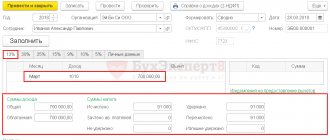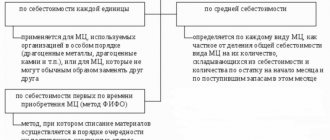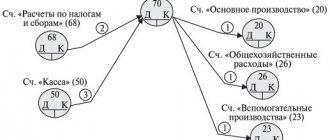What is VAT calculated?
Activities subject to VAT are any activities leading to an increase in the cost of a production product. In other words, when producing products, goods or any services, the seller sells them at a price higher than their cost.
VAT accrued arises upon sale and is taken into account in account 68 “Calculations for taxes and fees”, on the loan.
When selling products for the main activity of the enterprise, revenue is reflected in passive subaccount 90.1.1, and active subaccount 90 is used to reflect the amount of tax.
When selling in addition to the main activity (for example, when selling fixed assets), revenue is similarly reflected in account 91 “Other income and expenses”.
The trading company sells purchased goods in the amount of 236,000 rubles, as well as fixed assets, the sales amount is 178,000 rubles.
When selling goods, VAT is charged on the transaction:
| Dt | CT | Operation description | Amount, rub. | Document |
| 62 | 90(revenue) | Revenue reflected | 236 000 | Invoice |
| 90(VAT) | 68(VAT) | VAT charged | 36 000 | Invoice issued |
When selling OS, VAT is charged on the transaction:
| Dt | CT | Operation description | Amount, rub. | Document |
| 62 | 91(revenue) | Sales income reflected | 178 000 | Invoice |
| 91(VAT) | 68(VAT) | VAT charged | 27 153 | Invoice issued |
Typical entries for advances received and issued
Accounting records for advances are divided into prepayments received and advances issued. VAT on advances received is reflected as follows:
To account for calculations of value added tax, account 68 “Calculations for taxes and fees” is used, on which a separate sub-account 68.VAT is opened, on the credit of which tax is accrued for payment to the budget, the debit reflects its payment, as well as amounts sent for reimbursement from the budget.
An organization in the course of its activities faces value added tax in the following cases: when selling goods and products to customers (providing services, performing work) and purchasing goods (work, services) from a supplier.
In the first case, when selling a product, the organization is obliged to charge a tax on its value and pay it to the budget. VAT accrual is reflected in the following entry:
- If account 90 “Sales” is used to record sales transactions, then the VAT posting has the form D90/3 K68.VAT.
- If account 91 “Other income and expenses” is used to record sales transactions, then the posting is D91/2 K68.VAT.
That is, accrued VAT payable to the budget is collected on the credit of account 68.
In the second case, when purchasing a product, the organization has the right to send VAT for reimbursement from the budget (deduction); in this case, the tax is allocated from the total amount of the purchase and is accounted for separately in account 19 “Value added tax on acquired values” by posting D19 K60. After which VAT is sent for deduction, the transaction has the form D68.VAT K19.
As you can see, VAT for reimbursement from the budget is collected in the debit of account 68.
The total amount that must be paid to the budget is determined as the difference between the credit and debit of the account. 68. If loan turnover is greater than debit turnover, then the organization must pay value added tax to the budget; if loan turnover is less than debit turnover, then the state remains indebted to the organization.
VAT recoverable
Input VAT or VAT refundable (deductible) is the amount paid to the supplier as part of the purchased goods. In delivery documents, the tax amount is shown separately, on a separate line.
The same company purchases its goods from the supplier Panda LLC at a wholesale price. Let's assume that a batch of goods purchased earlier for the amount of 156,000 rubles was sold, including VAT - 23,797 rubles.
Posting for VAT reflection:
| Dt | CT | Operation description | Amount, rub. | Document |
| 41 | 60 | The received goods have been capitalized | 132 203 | Invoice |
| 19 | 60 | VAT allocated for deduction | 23 797 | Invoice received |
The following transactions are accepted for VAT deduction:
| Dt | CT | Operation description | Amount, rub. | Document |
| 68(VAT) | 19 | Amount claimed for deduction | 23 797 | Book of purchases |
In this way, you can calculate the amount of tax that Orion must pay to the budget. This amount is calculated as “VAT accrued” minus “VAT deductible”. This difference is equal to 36,000 rubles. — 23,797 rub. = 12,203 rub.
VAT accounting - postings when processing product returns
In situations where it is possible to return products in transactions, there are also special features. Here are two possible situations:
1. After the received products were received at the warehouse, it was discovered that they were defective.
- Dt 19 Kt 60 - the buyer has VAT reversed on defects given to the seller.
- Dt 68 Kt 19 - the buyer reverses VAT accepted for deduction in an amount corresponding to the volume of defects.
- Dt 90 Kt 68 - the seller’s tax entry is reversed when accepting defective products (if the return is made in the same period as the original shipment).
- Dt 91 Kt 68 - the seller’s tax entry is reversed (if defective products were received in subsequent periods).
2. The product has no disadvantages:
- Dt 90 Kt 68 - the buyer charges VAT on products to be returned.
- Dt 19 Kt 60 - the original seller shows input VAT on the return of products.
- Dt 68 Kt 19 - the original seller accepts VAT refund.
Similar articles
- Incoming and outgoing VAT
- Features of accounting for incoming and outgoing VAT
- Features of VAT taxation on intangible assets
- VAT is accepted for deduction - how to make an accounting entry?
- How to correctly reflect revenue - with or without VAT?
VAT on advances received
Flamingo LLC received an advance payment from the buyer in the amount of 98,000 rubles against the upcoming delivery of goods. The amount of VAT intended for restoration to the budget: 98,000 * 18/118 = 14,949 rubles.
VAT on advances received transactions::
| Dt | CT | Operation description | Amount, rub. | Document |
| 51 | 62 | Receipt of advance payment | 98 000 | Payment order |
| 76(advances) | 68(VAT) | VAT charged on advance payment | 14 949 | SF issued |
After the sale has taken place, that is, the goods have been shipped to the buyer, or after canceling the transaction and returning the advance payment, this VAT can be deducted.
VAT on transaction advances:
| Dt | CT | Operation description | Amount, rub. | Document |
| 68(VAT) | 76(advances) | VAT is presented for deduction to the budget | 14 949 | Book of purchases |
Example of VAT accounting with postings
The organization bought the goods from the supplier for 14,750 rubles. (including VAT). After which I sold it completely for 23,600 rubles. (VAT included).
A rate of 18% applies to this product.
How is accounting carried out in this case, what accounting entries for VAT need to be made (accrual and refund)?
Accounting for VAT refunds submitted by the supplier when purchasing goods:
The purchased goods are recorded on the account. 41. When purchasing goods from a supplier, the organization receives documents, including an invoice, in which the amount of value added tax is highlighted. If an organization is not exempt from paying VAT, then it has the right to separate it from the amount and send it for deduction; in this case, goods are included in the receipt at cost without taking into account tax.
That is, having received the goods and documents from the supplier, the organization breaks the cost indicated in the documents (14,750 rubles) into two components: VAT (2,250 rubles), which is taken into account by posting D19 K60, and the cost of goods without VAT (12,500 rubles) , accounting for which is reflected by posting D41 K60. Next, the organization uses its right to recover VAT from the budget and sends it for deduction using posting D68.VAT K19.
Once again, I would like to note that an organization can make the last posting only on the basis of an invoice. If the supplier does not present an invoice, then it will not be possible to reimburse this VAT.
Accounting for VAT on the sale of goods:
Next, the organization sells the goods. Since the sale of goods is a normal activity of the enterprise, an account is used to reflect sales transactions. 90. Postings for accounting for sales transactions:
- D90/2 K41 – cost of goods written off (12500)
- D62 K90/1 – reflects the amount of revenue from sales including VAT (23600)
- D90/3 K68.VAT – accrual of sales tax (3600).
Based on the results of the sale, it is possible to identify the financial result on the account. 90, which is determined as the difference between credit and debit turnover, for our example we have the financial result profit = 23600 – 12500 – 3600 = 7500 rubles.
This profit is reflected by posting D90/9 K99.
At the same time, in account 68.VAT, the debit shows the tax for reimbursement in the amount of 2250, and the credit shows the tax to pay in the amount of 3600. In total, the organization must pay 3600 - 2250 = 1350 rubles to the budget.
Value added tax is an indirect tax. This concept means that it occurs at all stages of production, but is paid to the budget as it is sold. It is important to keep VAT records correctly and correctly generate VAT transactions.
VAT happens:
- Input - intended for deduction when purchasing goods, services, etc.;
- To be restored - the amount of tax that the seller must transfer to the budget.
VAT on advances issued
An organization has the right to receive a VAT deduction from advances transferred towards future deliveries if there is an SF and the contract specifies the condition for advance payment.
against the upcoming receipt of equipment, transfers an advance in the amount of 95,000 rubles.
VAT on advances issued by transactions:
| Dt | CT | Operation description | Amount, rub | Document |
| 60 | 51 | Advance transferred | 95 000 | Payment order ref. |
| 68 | 76(advances) | VAT is deductible | 14 492 | Book of purchases |
| 08 | 60 | Equipment accepted for registration | 77 900 | Invoice |
| 19 | 60 | VAT on delivery allocated | 17 100 | SF supplier |
| 68 | 19 | VAT is deductible | 17 100 | Book of purchases |
| 76(advances) | 68 | Recovered VAT from advance payment | 14 492 | Sales book |
VAT accrual on receipts
VAT is subject to:
- Sale of goods, services, works in Russia.
- Transfer of property rights.
- Production for own consumption.
- Construction and installation works for own consumption.
- Import operations.
In any case, the place of sale must be the territory of the Russian Federation. This means that the goods must be stored or located at the time of shipment in the Russian Federation, the services provided by the company must be performed in the Russian Federation or territories under its jurisdiction, the points of departure are the Russian Federation, etc.
To find the tax base for VAT, it is determined at the time of the day of transfer of goods to the buyer (provision of services, etc.), or at the time of receipt of funds for this sale. If the contract provides for advances, then the base will need to be calculated several times. In this case, estimated tax rates must be applied.
VAT tax rates:
- 0%
- 10%
- 18%
- 10/110 and 18/118
For transactions subject to VAT, it is necessary to prepare invoices or UTD. Documents are drawn up in two copies. They are recorded by the supplier and buyer in the sales and purchases ledger. Intermediaries performing transactions subject to VAT must keep a journal of invoices.
The tax is calculated separately for each rate if the company applies several. They are then added up to arrive at the total tax amount. VAT is calculated by filling out a declaration.
VAT on sales is accrued in the debit of account 90.3. For non-operating income – 91.2. The loan corresponds to account 68.
- Debit 90.3 Credit 68 – VAT on sales upon shipment
- Debit 90.3 Credit 76 – VAT on sales upon payment
- Debit 91.2 Credit 68 – VAT on non-operating income shipped
- Debit 91.2 Credit 68 – VAT on non-operating income paid
VAT penalties
In case of late payment of tax, the organization is obliged to calculate and transfer penalties for the delay. Penalties are calculated at 1/300 of the Central Bank refinancing rate independently, or as a result of a tax audit.
The calculated amounts of VAT penalties in accounting are displayed by postings:
| Dt | CT | Operation description | Document |
| 99 | 68 | The amount of the penalty is reflected | Accounting information |
Typical VAT entries for purchased assets
VAT on purchased assets and services is accounted for using the following entries:
Debit 19 Credit 60 - reflection of “input” VAT on purchased fixed assets, intangible assets, materials, capital investments, works, services. Posting is done based on the received invoice.
Debit 20 (23, 29) Credit 19 - write-off of VAT on acquired assets and services that will be used in transactions not subject to VAT. The posting is made on the basis of an accounting calculation prepared by a certificate.
Debit 91 Credit 19 - write-off of VAT on other expenses if the invoice from the supplier was not received, lost or filled out incorrectly.
See also the material “What are the grounds and how to write off VAT on 91 accounts?”
Debit 20 (23, 29) Credit 68 - restoration of VAT previously claimed for reimbursement of inventories and services used for transactions not subject to VAT. The basis of the posting is again a reference calculation.
For reasons for VAT restoration, see the material “When to restore VAT”
Debit 68 Credit 19 - reflection of VAT deductible on inventories and services, including in the case of confirmation of the fact of export. Posting is done on the basis of invoices, and when confirming exports, after submitting the documents listed in Article 165 of the Tax Code of the Russian Federation to the Federal Tax Service and receiving the appropriate decision.
See also “What are VAT tax deductions?”
VAT tax agent
A tax agent is an organization (person) that is responsible for withholding tax and transferring it to the budget. For example, when leasing state property, the tax agent’s VAT entries look like this:
| Dt | CT | Operation description |
| 26(20,44, etc.) | 60(76) | Reflection of services |
| 60(76) | 68 | Reflection of VAT for the agent |
| 19 | 60(76) | Input VAT |
| 68 | 51 | Reflection of tax remittance by agent |
| 68 | 19 | VAT refundable at the time of tax transfer |
Typical accounting entries for VAT: tax accounting
VAT accounting involves not only reflecting transactions in tax accounting registers, but also reflecting them on accounting accounts. Accounting entries for VAT accounting are necessary for the correct reflection of this tax in accounting when performing various transactions. In this article, we will recall the main VAT entries, and also consider several cases that are often encountered in the work of an accountant.
VAT postings. Basic Rules
Typical VAT entries for purchased assets
Typical VAT transactions on sales
If VAT is calculated by tax agents
Typical VAT transactions when returning goods
To account for VAT calculations, use account 68 “Calculations for taxes and fees” and account 19 “Value added tax on acquired assets”. A special subaccount 68.VAT is created for account 68. The credit of this account records accrued VAT, and the debit reflects the tax paid and amounts reimbursed from the budget. Account 19 in accounting is used to reflect input tax received from suppliers, but not yet reimbursed from the budget. Sub-accounts are also opened for account 19 “Value added tax on acquired values” depending on the type of values received.
Input VAT
Accounting for input VAT on purchased assets (goods, works, services) is reflected in the following accounting entries:
| Postings | Operation description |
| Dt 19 Kt 60 | Accounting for input VAT on purchased goods, works and services |
| Dt 20 Kt 19 | Write-off of input VAT for those assets that, when used in production processes, are not subject to tax contributions. Such a record is made using a calculation certificate drawn up by an accountant. |
| Dt 91 Kt 19 | VAT on purchased assets was written off as other expenses due to a missing or incorrectly drawn up invoice |
| Dt 20, 23, 29 Kt 68 | VAT recovery - entries for inventories and services that are used for production procedures and are not subject to taxation |
| Dt 68 Kt 19 | For tax deduction |
Procedure for calculating VAT subject to payment or reimbursement
Based on the results of the reporting period, VAT payers make calculations on the accrued amounts of VAT payable and the amount of tax deductions. If a positive difference is formed between these indicators, then this difference is the amount of VAT that the payer must transfer to the budget. If the difference is negative, an amount equal to this value can be submitted for reimbursement or included in the tax deduction for future periods.
Example 1
During the reporting period, the organization sold products worth $60,000$ rubles. (including VAT). All products sold are taxed at the general rate of $18\%$ VAT accrued is: $60,000 - (60,000 : 1.18) = $9,153 rub. During the same reporting period, the organization purchased raw materials, materials, etc. from suppliers in the amount of $45,000 rubles. (including VAT). VAT deductible is: $45,000 - (45,000 : 1.18) = $6,864 rub. VAT payable will be: $9153 - 6864 = $2289 rubles.
Basic provisions of VAT
Definition 1
Value added tax (VAT) is an indirect federal tax, which represents part of the newly created value generated at each stage of production and circulation. The VAT amount is included in the sales price of goods, works or services, and is actually paid by the end consumer.
Currently there are three VAT rates.
$18\%$ – Total bet
$10\%$ – rate on certain groups of goods (children's goods, medical and other so-called essential goods).
$0\%$ –export, trade in precious metals, space exploration, etc.,
The objects of VAT are (Fig. 1):
Figure 1. VAT objects
Finished works on a similar topic
- Course work VAT accounting 480 rub.
- Abstract VAT accounting 280 rub.
- Test work VAT accounting 250 rub.
Receive completed work or specialist advice on your educational project Find out the cost
Subjects (payers) of VAT are enterprises and individual entrepreneurs who are payers of this tax.
The general rule for determining the tax base for VAT is that the base is one of the events that occurred first:
- day of payment, partial payment for upcoming deliveries of goods (performance of work, provision of services);
- day of shipment (transfer) of goods (work, services).
Article $171$ of the Tax Code of the Russian Federation provides for deductions.
VAT amounts that are subject to deductions are:
- presented by suppliers or contractors when delivering goods (works, services);
- paid when importing goods into the territory of the Russian Federation;
- paid when importing goods into the territory of the Russian Federation from the territory of member states of the Customs Union.
“Input” VAT can be deducted only after the goods (work, services) have been accepted for accounting and the corresponding primary documents and invoices are available.
VAT is calculated by adding the appropriate rate to the product or service.







